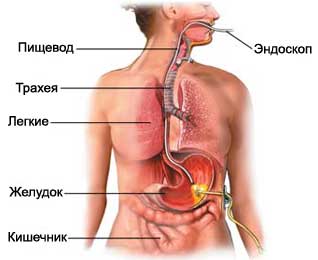Percutaneous endoscopic gastrostomy – CHEG
Description percutaneous endoscopic gastrostomy
Percutaneous endoscopic gastrostomy (CHEG) It is a procedure for the introduction of feeding tube in the stomach through the abdominal wall.
Reasons for percutaneous endoscopic gastrostomy
Gastrostomy tube is mainly used as an alternative feeding method. It is used in the following cases:
- Feeding at the inability of chewing and swallowing;
- Drain accumulated liquid from the stomach.
Possible complications of percutaneous endoscopic gastrostomy
If you plan to CHEG, you need to know about possible complications, which may include:
- Problems with the installation of pipes for CHEG;
- Aspiration – random absorption liquid into the airways, food or foreign substances;
- Damage to other organs;
- Mucositis abdomen;
- Infection;
- Abdominal distention;
- Nausea;
- Diarrhea;
- Skin irritation around the tube;
- Death.
Factors, that may increase the risk of complications:
- Obesity and diabetes;
- Smoking;
- Alcohol abuse or drug use;
- The use of some drugs;
- Previous abdominal surgery;
- Advanced age.
How is the percutaneous endoscopic gastrostomy?
Preparing for CHEG
Before the surgery, the doctor may prescribe, or to hold the next:
- Medical checkup;
- Examine the history of the disease;
- Conduct a review of the medication;
- Blood and urine tests;
- X-ray of the abdomen;
- Endoscopic examination of the stomach using an endoscope – long tube with a camera on the end, which is inserted through the throat into the stomach.
In the run-up procedure:
- Tell your doctor about taking any medications. A week before surgery you may be asked to stop taking certain drugs:
- Aspirin or other anti-inflammatory drugs;
- Blood thinners, such as clopidogrel (Plaviks) or warfarin;
- Do not eat or drink for at least eight hours before the procedure.
We need to organize a trip for the operation and back home from the hospital.
Anesthesia
During the CHEG local anesthesia, usually in the form of a spray with lidocaine, which blocks the pain and discomfort in the throat. Also often analgesic administered through an intravenous catheter in the arm.
When using local anesthesia in conjunction with it and This is used sedative.
Procedure Percutaneous endoscopic gastrostomy
Sometimes some time before the procedure you need to take antibiotics.
First introduced endoscope – a long thin tube with a camera and a light source at the end. It will be inserted through the mouth and throat into the stomach. The camera transmits the image on the monitor screen. The doctor will use the images, to find the right place for the insertion of a tube CHEG.
The selected location through the abdominal wall into the stomach needle is inserted. With the help of an endoscope the doctor finds the end of the needle inside the body. Through this needle is inserted into the stomach thin thread, which captures the forceps and pull through the mouth. Thus the thread enters the front of the abdomen, It is going through the stomach, and out of his mouth. It joins the thread tube CHEG. The yarn is drawn back into the abdominal cavity.
On the abdomen it will be made a small incision, through which the tip of the tube to be withdrawn. To the outer end of the tube will be attached ČÈG soft, Round seal, which will hold it in a fixed position. Around the incision will host the sterile gauze. Finally, CHEG tube is secured to the skin of the abdomen.

How long will the percutaneous endoscopic gastrostomy?
30-45 minutes.
Percutaneous endoscopic gastrostomy – Will it hurt?
Anesthesia prevents pain during the procedure. A few days after CHEG may feel slight pain and tenderness at the incision site. It may also be a sense of muscle tension. Doctor will prescribe medication, to reduce discomfort.
The average hospital stay after percutaneous endoscopic gastrostomy
Usually stay is one day. Your doctor may prolong hospitalization, if there were complications.
Caring for a patient after percutaneous endoscopic gastrostomy
- When you are in bed, you need to keep your feet in the raised position, to avoid the formation of blood clots;
- Do not smoke;
- Take pain medications as directed by your doctor. Avoid taking aspirin or aspirin-containing medications;
- To speed up the healing should go back to normal activities;
- Ask the doctor, when it is safe to shower, bath or expose the surgical site to water;
- Be sure to follow your doctor's instructions;
- Learn how to eat yourself through the feeding tube:
- Within one or two days after CHEG liquid will be administered through the IV . Then you start getting clear liquids through a tube CHEG. If no problems, you can begin to feed through the tube;
- A dietitian will teach you how to use the phone CHEG. He also tells, how to choose the right food;
- We must remain in an upright position for 30-60 minutes after a meal;
- Learn to care for the tube:
- Change your sterile gauze, placed around the incision site;
- Regularly rinse CHEG tube and the skin around it, to avoid infection;
- Find Out, emptying the stomach through the tube;
- Learn to recognize and solve problems, eg, how to clear a blocked pipe, or correct tube, shifted from the place;
- Secure the tube with tape, when not in use. This will prevent its displacement.
Contact your doctor after percutaneous endoscopic gastrostomy
After discharge from the hospital need to see a doctor, If the following symptoms:
- Pain, which does not pass after taking pain medication appointed;
- The problems in the selection or around the tube;
- Signs of infection, including fever and chills;
- Redness, edema, increased pain, excessive bleeding, or discharge from the incision;
- Headache, muscle aches, dizziness or malaise;
- Nausea, vomiting, constipation, abdominal distention.
